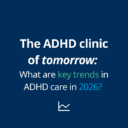The ADHD patients of 2026 are knowledgeable, not just about the condition, but also how it’s assessed and…
Guides
The ADHD clinic of tomorrow: What are key trends in ADHD care in 2026?
ADHD care is rapidly evolving. As 2026 approaches, we take a look at the top 5 trends shaping…

ADHD in Complex Cases: Clinician Guide & FAQs
People with ADHD may develop coping or masking strategies to manage their symptoms, especially if they are undiagnosed for a long time….

QbCheck in practice: A clinician guide to using objective data in ADHD evaluations
Objective data plays an increasingly important role in today’s world of high-quality ADHD care. We know its importance, but how can…

What does management of ADHD look like in older adults?
Late-diagnosed ADHD is becoming increasingly common, with more adults receiving a diagnosis in their 50s or 60s. ADHD…

What does the gold standard of ADHD diagnosis and treatment look like in 2025 and beyond?
In 2025, the gold standard of ADHD diagnosis and treatment is evolving, shaped by updated DSM-5 criteria, new…

Understanding ADHD in 2025: Prevalence, diagnosis, guidance, and treatment
Our understanding of ADHD, the symptoms, treatment options, and assessment methodologies, is evolving rapidly. In a short time,…

Objective testing: A cost-saving approach to smarter ADHD care for clinics worldwide
ADHD is a global issue and healthcare providers face common challenges; providing equitable patient experiences across boundaries, reducing…

ADHD and comorbidities: What virtual providers need to know when diagnosing and managing ADHD
ADHD rarely exists in isolation. The prevalence of coexisting conditions such as anxiety, depression, substance use disorders…

Marketing ADHD services to patients: A guide to branding and communications strategy
Marketing is an integral tool for growing any business. For ADHD clinicians and providers, it helps scale…

About
Our guides are designed to support clinicians like you navigate the complexities of ADHD treatment and diagnosis.
You can better understand how our ADHD tests work and how you can use them to effectively support your patients.
